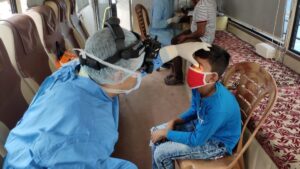One Day, Two Eyes, Lifelong Clarity: The Magic of LASIK in a Nutshell
Introduction
Imagine waking up and seeing your alarm clock without fumbling for glasses. Or stepping into the shower and still being able to read the labels on your shampoo bottles. These are simple moments many take for granted—until they experience clear vision after LASIK.
Laser eye surgery, particularly LASIK (Laser-Assisted In Situ Keratomileusis), has surged in popularity over the last two decades. It’s no longer seen as an elite procedure for a few—it’s an accessible, life-changing option for millions who are tired of depending on glasses or contacts.
Why It’s More Than Convenience
The benefits of laser eye surgery go far beyond tossing your glasses case in a drawer. It’s about reclaiming your freedom. Whether you’re traveling, hiking, swimming, or just trying on sunglasses at the store, the absence of corrective lenses changes how you live.
See more: 5 Signs indicating that you have Sleep Apnea
There’s also an emotional shift. Many patients report a noticeable boost in confidence. No more fogged-up lenses, no more hesitating to join in on spontaneous activities. Even makeup application becomes easier and more enjoyable without the barrier of glasses.
Then there’s the long-term financial benefit. Glasses and contacts aren’t just one-time purchases—they’re recurring expenses. New prescriptions, frames, cleaning solutions, and replacement lenses can add up to thousands over a decade. In contrast, LASIK is a one-time investment that often pays for itself over time.
Life Improvements After Surgery
The morning after LASIK can feel surreal. Many patients describe it as a “wow” moment—opening their eyes and seeing clearly without assistance for the first time in years. It’s not just about visual clarity; it’s about mental clarity too.
Imagine waking up for an early flight and not needing to search for your glasses. Or going camping without worrying about contact lens hygiene. These small yet meaningful shifts bring a level of ease and simplicity to everyday life.
Psychologically, the results can be profound. Less dependence on visual aids reduces stress and anxiety for many. It can also lead to a more active lifestyle, as clear vision makes it easier to engage in physical activities, sports, or even just a brisk evening walk.

Understanding the Technology & Safety
So, how does it work? In simple terms, LASIK reshapes the cornea—the clear front part of the eye—so that light entering the eye is properly focused onto the retina. Think of it like adjusting a camera lens for the perfect shot.
The procedure is incredibly fast. Most treatments are done in under 15 minutes for both eyes. And yes, you’re awake the whole time—but numbing drops make it painless. The actual laser work takes less than a minute per eye.
As for safety? LASIK is one of the most studied and refined elective surgeries. With decades of data and technology improvements, it has an outstanding safety record. Modern lasers are so precise they can track eye movement in real time, adjusting as needed during surgery.
When It Makes Sense to Consider Surgery
Laser eye surgery isn’t for everyone, but it’s perfect for many—especially those in their 20s to 40s. At this age, your vision has typically stabilized, and your eyes are healthy enough to undergo correction.
Whether you’re nearsighted (can’t see far), farsighted (can’t see close), or have astigmatism (blurry at all distances), LASIK could be a solution. A comprehensive exam with a qualified specialist can determine your eligibility.
If you’ve been thinking about it for years, your 30s are often the ideal time to go for it. You’re still young enough to enjoy decades of benefit, but likely old enough that your prescription has settled.
Risks and Considerations
Like all surgeries, LASIK has risks. Some patients experience temporary dryness, glare, or halos at night—though these often fade with time. There’s also a small chance of needing a touch-up procedure down the line.
That said, serious complications are rare. The key is to choose a trusted eye specialist and follow all pre- and post-operative care instructions. Not everyone is a candidate, which is why a professional consultation is essential. Your doctor will consider the shape of your eyes, your health history, and your lifestyle before giving the green light.
Conclusion
Laser eye surgery isn’t just about fixing vision—it’s about changing lives. The ability to see clearly without relying on glasses or contacts is a gift that impacts everything from your daily routine to your self-esteem.
If you’ve been on the fence, it might be time to look at laser eye surgery not as a luxury, but as an investment in yourself. After all, your vision affects how you experience the world. Why not experience it in high definition?
Take the first step. Book a consultation. Ask questions. And picture what your life could look like with clear, effortless vision.




